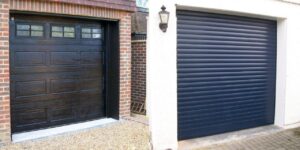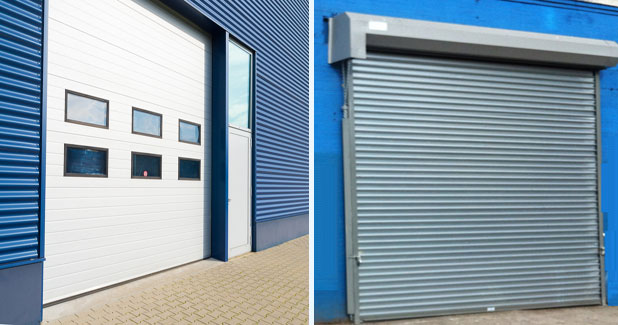
Rolling Gates vs Overhead Doors: Which One is the Best Fit?
 When it comes to choosing the right entry system for your property, understanding the key differences between rolling gates vs overhead doors is essential. Both serve the same general purpose—security, access control, and protection—but each has unique features that can make one a better option than the other depending on your needs. Whether for commercial, industrial, or residential applications, this guide will break down the critical factors to help you decide which door type offers the best fit.
When it comes to choosing the right entry system for your property, understanding the key differences between rolling gates vs overhead doors is essential. Both serve the same general purpose—security, access control, and protection—but each has unique features that can make one a better option than the other depending on your needs. Whether for commercial, industrial, or residential applications, this guide will break down the critical factors to help you decide which door type offers the best fit.
Design and Functionality Explained
Both rolling gates and overhead doors operate on different mechanical systems. Rolling gates typically roll up into a compact coil above the opening, making them ideal for tight spaces. They offer a vertical lift that requires minimal overhead room. Overhead doors, on the other hand, are lifted along tracks and lay flat on the ceiling area when open.
Rolling gates are often preferred for high-traffic and industrial environments due to their durability. Overhead doors are commonly seen in residential garages and light commercial facilities. Both types can be motorized for convenience and offer varying levels of insulation and security.
- Rolling gates save space.
- Overhead doors offer aesthetic appeal.
- Rolling gates are more durable for commercial use.
- Overhead doors are ideal for residential garages.
- Both options can be customized.
- Motorization available for both.
Security Features of Each Option
When comparing rolling gates vs overhead doors, security is a major factor. Rolling gates are generally constructed from steel or aluminum slats, offering greater resistance against forced entry. Their design makes tampering more difficult. They are ideal for storefronts and warehouses needing heavy-duty protection.
Overhead doors provide good security as well but may be more susceptible to break-ins if not properly reinforced. Many overhead models now come with smart locks, security sensors, and heavy-duty materials to bridge the security gap.
- Steel construction enhances gate strength.
- Overhead doors benefit from modern tech.
- Rolling gates resist vandalism.
- Overhead doors are easier to accessorize.
- Security seals available for both types.
- Alarm integration is an option.
Installation Considerations
Installing rolling gates can be quicker and less intrusive than overhead doors, especially in tight areas. Because they coil into a compact space, there is no need for ceiling tracks or large structural changes. This makes them an excellent fit for small storefronts or alleyways.
Overhead doors typically require more clearance space and structural support, especially for larger installations. Residential setups are usually straightforward, but industrial applications may require customized framing.
Proper installation ensures longevity and efficiency. Always use certified professionals who specialize in the type of system being installed.
Maintenance and Longevity
Another vital aspect when comparing rolling gates vs overhead doors is maintenance. Rolling gates require regular lubrication and occasional alignment, especially in high-use scenarios. Their simple mechanism often means fewer parts can go wrong.
Overhead doors, due to the track and spring system, may require more frequent servicing. Rollers, cables, and tracks can wear out, making routine inspection important. With good maintenance, both types can last for decades.
- Lubrication keeps gates running smoothly.
- Overhead springs require checks.
- Rolling gates resist debris and weather.
- Overhead tracks can get misaligned.
- Regular inspection extends life.
- Warranties often cover mechanical parts.
Aesthetic and Customization Options
Overhead doors generally offer more aesthetic flexibility. Homeowners can choose from a wide range of materials, colors, windows, and finishes to match their home’s design. This makes overhead doors a preferred choice in residential markets.
Rolling gates are more functional in appearance but still offer some customization. Powder coating, perforated designs, and branding are all possible. They are designed for durability and utility over appearance but can still be adapted to fit business branding.
- Overhead doors enhance curb appeal.
- Rolling gates are functional and sleek.
- Window inserts available in overhead designs.
- Custom colors and finishes available.
- Rolling gates can feature logos.
- Modern designs elevate both styles.
Cost Analysis: Which Offers More Value?
In terms of cost, rolling gates can be more affordable for commercial setups due to their simplicity. However, customization, motorization, and security add-ons can increase the final price. For business owners needing reliability and security, the value is clear.
Overhead doors may start with lower base prices for standard residential models, but high-end or insulated options can get expensive. Installation complexity also adds to the cost. Consider both upfront and long-term maintenance costs when choosing.
- Rolling gates offer long-term durability.
- Overhead doors give aesthetic flexibility.
- Pricing varies by size and features.
- Both offer value for their respective uses.
- ROI depends on maintenance and efficiency.
- Consider repair costs over time.
Durability in Extreme Conditions
Rolling gates vs overhead doors durability often depends on the environment. Rolling gates, especially galvanized or stainless steel types, perform better in harsh weather. They’re resistant to corrosion, dust, and temperature extremes.
Overhead doors also offer weather-resistant options, especially those with proper insulation and sealing. However, their exposed track systems may be affected by ice or debris if not maintained regularly. Ensure your choice fits your climate needs.
- Steel gates fight rust.
- Insulated overhead doors reduce energy loss.
- Rolling gates are ideal for industrial zones.
- Overhead doors suit suburban homes.
- Both benefit from weather seals.
- Proper finishes enhance lifespan.
Noise and Operation
Noise level may influence your decision between rolling gates vs overhead doors. Rolling gates, especially older or poorly maintained ones, can be louder during operation. Adding rubber insulation and modern motors can reduce noise.
Overhead doors tend to be quieter, particularly models with nylon rollers and belt-driven openers. This makes them ideal for homes and noise-sensitive areas. Consider acoustic performance when choosing your system.
- Modern motors reduce rolling gate noise.
- Nylon rollers cut overhead door sound.
- Lubrication affects both types.
- Insulation helps muffle operation.
- Choose quiet options for homes.
- Noise impacts user experience.
Use Case Recommendations
Choose rolling gates if your priority is security, compact design, and low-maintenance in a high-traffic commercial environment. They work best for retail stores, warehouses, and tight alleyways.
Opt for overhead doors when appearance, quiet function, and customization matter more. They’re perfect for homes, showrooms, and residential garages. Think about your long-term use, environment, and aesthetic preferences.
- Rolling gates for durability.
- Overhead doors for design appeal.
- Choose based on traffic volume.
- Assess your space constraints.
- Think about daily usage levels.
- Match your building’s purpose.
Contact Us to Learn More
Still unsure about rolling gates vs overhead doors for your property? Our experts at Williams Garage Doors are here to help you make the best decision.
Call us in Pennsylvania at 215-792-4424 or in New Jersey at 856-606-2937. You can also email us directly at williamsgaragedoors1@gmail.com.
For more details, check out resources like the International Door Association to compare more options.
No matter your choice, professional guidance can help you find the perfect fit that balances function, security, and style.



